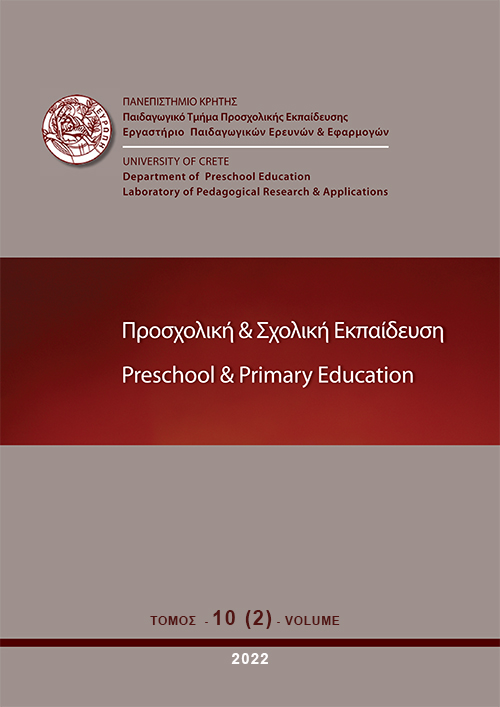Το μουσείο ως παιδαγωγικό εργαλείο για τη μάθηση: Παράγοντες που επηρεάζουν την πρόθεση αξιοποίησής του από φοιτητές τμημάτων αγωγής της πρώιμης παιδικής και εκπαίδευσης της προσχολικής και της σχολικής ηλικίας

Résumé
Κατά το μεγαλύτερο μέρος της ζωής μας μαθαίνουμε έξω από το επίσημο-τυπικό εκπαιδευτικό σύστημα, δηλαδή τα σχολεία, σε περιβάλλοντα μη-τυπικής ακόμα και άτυπης εκπαίδευσης και μέσα από τη δόμηση εμπειριών. Το μουσείο αποτελεί μια μη-τυπική και ταυτόχρονα ιδιαίτερα επικοινωνιακή μορφή αγωγής και εκπαίδευσης που απευθύνεται σε όλες τις ηλικίες, σε πολλές περιπτώσεις ακόμη και σε παιδιά ηλικίας κάτω των 2 ετών. Το σύγχρονο μουσείο αναγνωρίζεται ως εκπαιδευτικός οργανισμός και διαρκώς ενισχύει και εκσυγχρονίζει το έργο του προς την κατεύθυνση αυτή. Ωστόσο, από την πλευρά του σύγχρονου σχολείου εντοπίζονται ορισμένα ζητήματα κυρίως ως προς τον ρόλο των εκπαιδευτικών απέναντι στο μουσείο και την παιδαγωγική αξιοποίησή του από τους ίδιους. Η παρούσα ερευνητική εργασία εξετάζει τις στάσεις και τις αντιλήψεις μελλοντικών παιδαγωγών για το μουσείο και τη μουσειακή εμπειρία ως παιδαγωγικό εργαλείο, επιχειρώντας να φωτίσει τους παράγοντες που επηρεάζουν την πρόθεσή τους να το αξιοποιήσουν στην τάξη. Ως ερευνητικό πλαίσιο χρησιμοποιήθηκε το μοντέλο της θεωρίας της προσχεδιασμένης συμπεριφοράς (TPB). Τον πληθυσμό μας αποτέλεσαν τεταρτοετείς και άνω φοιτητές των πανεπιστημιακών τμημάτων αγωγής της πρώιμης παιδικής και εκπαίδευσης της προσχολικής και της σχολικής ηλικίας, ενώ το δείγμα μας επιλέχθηκε με τυχαία δειγματοληψία. Η ανάλυση και στατιστική επεξεργασία των δεδομένων έγινε με τη μέθοδο ανάλυσης μοντέλων Δομικών Εξισώσεων (Structural Equation Modeling - SEM). Τα αποτελέσματα έδειξαν αυξημένη πρόθεση των μελλοντικών παιδαγωγών να αξιοποιήσουν το μουσείο και την μουσειακή εμπειρία ως παιδαγωγικό εργαλείο, ενώ οι στάσεις, τα υποκειμενικά πρότυπα και ο αντιλαμβανόμενος συμπεριφορικός έλεγχος εξηγούν το 76,7% της διακύμανσης της πρόθεσης. Τα ευρήματα προσφέρουν ποικίλες πληροφορίες που μπορούν να συνεισφέρουν σημαντικά στον σχεδιασμό εκπαιδευτικής πολιτικής για την κάθε βαθμίδα εκπαίδευσης, η οποία θα ευθυγραμμίζεται με τις σύγχρονες διεθνείς τάσεις για βιωματικές προσεγγίσεις και αξιοποίηση μη-τυπικών μορφών μάθησης, εστιάζοντας παράλληλα στην παιδεία και τον πολιτισμό.
Article Details
- Comment citer
-
Δημητριάδη Σ., & Μαλαφάντης Κ. (2022). Το μουσείο ως παιδαγωγικό εργαλείο για τη μάθηση: Παράγοντες που επηρεάζουν την πρόθεση αξιοποίησής του από φοιτητές τμημάτων αγωγής της πρώιμης παιδικής και εκπαίδευσης της προσχολικής και της σχολικής ηλικίας. Preschool and Primary Education, 10(2), 122–152. https://doi.org/10.12681/ppej.27843 (Original work published 1 novembre 2022)
- Rubrique
- Άρθρα

Ce travail est disponible sous licence Creative Commons Attribution - Pas d’Utilisation Commerciale - Partage dans les Mêmes Conditions 4.0 International.
Οι συγγραφείς των άρθρων που δημοσιεύονται στο ΠΡΟΣΧΟΛΙΚΗ & ΣΧΟΛΙΚΗ ΕΚΠΑΙΔΕΥΣΗ διατηρούν τα δικαιώματα πνευματικής ιδιοκτησίας επί των άρθρων τους, δίνοντας στο περιοδικό το δικαίωμα της πρώτης δημοσίευσης. Άρθρα που δημοσιεύονται στο ΠΡΟΣΧΟΛΙΚΗ & ΣΧΟΛΙΚΗ ΕΚΠΑΙΔΕΥΣΗ διατίθενται με άδεια Creative Commons 3.0 και σύμφωνα με την άδεια μπορούν να χρησιμοποιούνται ελεύθερα, με αναφορά στο/στη συγγραφέα και στην πρώτη δημοσίευση για μη κερδοσκοπικούς σκοπούς και με δικαίωμα τροποποίησης μόνον με παρόμοια διανομή (αν αναμείξετε, τροποποιήσετε, ή δημιουργήσετε πάνω στο υλικό, πρέπει να διανείμετε τις δικές σας συνεισφορές υπό την ίδια άδεια όπως και το πρωτότυπο). To Εργαστήριο Παιδαγωγικών Ερευνών και Εφαρμογών του Παιδαγωγικού Τμήματος Προσχολικής Εκπαίδευσης του Πανεπιστημίου Κρήτης και το Εθνικό Κέντρο Τεκμηρίωσης διατηρούν το δικαίωμα να δημοσιεύουν, να αναπαραγάγουν, να παρουσιάζουν στο κοινό, να διανέμουν και χρησιμοποιούν άρθρα που δημοσιεύονται στο ΠΡΟΣΧΟΛΙΚΗ & ΣΧΟΛΙΚΗ ΕΚΠΑΙΔΕΥΣΗ σε οποιοδήποτε μέσο και μορφή είτε μεμονωμένα είτε ως μέρη συλλογικών έργων, για όλο το χρόνο διάρκειας προστασίας της πνευματικής ιδιοκτησίας και για όλες τις χώρες του κόσμου. Αυτό περιλαμβάνει ενδεικτικά και όχι αποκλειστικά, το δικαίωμα δημοσίευσης των άρθρων σε τεύχη του περιοδικού ΠΡΟΣΧΟΛΙΚΗ & ΣΧΟΛΙΚΗ ΕΚΠΑΙΔΕΥΣΗ, αναπαραγωγής και διανομής μεμονωμένων αντιγράφων των άρθρων, αναπαραγωγής ολόκληρων των άρθρων σε άλλη έκδοση του Εργαστηρίου Παιδαγωγικών Ερευνών και Εφαρμογών του Παιδαγωγικού Τμήματος Προσχολικής Εκπαίδευσης του Πανεπιστημίου Κρήτης και του Εθνικού Κέντρου Τεκμηρίωσης και αναπαραγωγής και διανομής των άρθρων ή περίληψης αυτών με χρήση πληροφορικού συστήματος αποθετηρίου.


